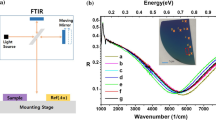Abstract
This research introduces a novel method of ensuring more reliable measurement of thin film thickness in spectroscopic reflectometer. Nonlinear fitting is the method most commonly used for measuring thin film thickness; however, it runs into the problem of a local minimum, which entails ambiguity. To improve measurement, prior to analysis of spectral reflectance profiles using nonlinear fitting, initial thickness value is estimated based on convolutional neural networks. Due to the supportive role of convolutional neural networks, thin film thickness can be determined without ambiguity.












Similar content being viewed by others
Abbreviations
- \(d\) :
-
Thickness of thin film
- \(k\) :
-
Spectral wavenumber
- \(R\) :
-
Total reflection coefficient
- \(r_{12}\) :
-
Fresnel reflection coefficients of top boundaries of thin films
- \(r_{23}\) :
-
Fresnel reflection coefficients of bottom boundaries of thin films
- \(N\) :
-
Refractive index of thin films
- \(R_{ref}\) :
-
Spectral reflectance of reference specimen
- \(G_{ref}\) :
-
Spectral density of reference specimen
- \(G_{sam}\) :
-
Spectral density of unknown film thickness sample
- \(R_{sam}\) :
-
Spectral reflectance of unknown film thickness
- \(\theta_{1}\) :
-
Angle of incidence
- \(\theta_{2}\) :
-
Angle of refraction
- \(w\) :
-
Value of the kernel
- \(v\) :
-
Value of feature map
- \(b\) :
-
Additive bias
- \(p\) :
-
Position in a kernel
- \(x\) :
-
Position of unit in a feature map
- \(i\) :
-
Layer of a feature map
References
Piegari, A., & Masetti, E. (1985). Thin film thickness measurement: A comparison of various techniques. Thin Solid Films,124(3), 848–852.
Debnath, S. K., You, J. H., & Kim, S. W. (2009). Determination of film thickness and surface profile using reflectometry and spectrally resolved phase shifting interferometry. International Journal of Precision Engineering and Manufacturing,10(5), 5–10.
Seo, Y. B., Yon, Y. H., & Joo, K. N. (2016). 3D multi-layered film thickness profile measurements based on photometric type imaging ellipsometry. International Journal of Precision Engineering and Manufacturing,17(8), 989–993.
Kihara, T., & Yokomori, K. (1990). Simultaneous measurement of refractive index and thickness of thin film by polarized reflectances. Applied Optics,29(34), 5069–5073.
Urbánek, M., Spousta, J., Behounek, T., & Sikola, T. (2007). Imaging reflectometry in situ. Applied Optics,46, 6309–6313.
Ohlídal, M., Ohlídal, I., Klapetek, P., Nečas, D., & Majumdar, A. (2011). Measurement of the thickness distribution and optical constants of non-uniform thin films. Measurement Science & Technology,22, 085104.
Jo, T., Kim, K. R., Kim, S. R., & Pahk, H. J. (2014). Thickness and surface measurement of transparent thin-film layers using white light scanning interferometry combined with reflectometry. Journal of the Optical Society of Korea,18(3), 236–243.
Kim, K. R., Kim, S. R., Kwon, S. Y., & Pahk, H. J. (2014). Volumetric thin film thickness measurement using spectroscopic imaging reflectometer and compensation of reflectance modeling error. International Journal of Precision Engineering and Manufacturing,15(9), 1817–1822.
You, J. W., Kim, S. H., & Kim, D. S. (2008). High speed volumetric thickness profile measurement based on full-field wavelength scanning interferometer. Optics Express,16(25), 21022–21031.
Lawrence, S., Giles, C. L., Tsoi, A. C., & Back, A. D. (1997). Face recognition: A convolutional neural network approach. IEEE Transactions on Neural Networks,8(1), 98–113.
Krizhevsky, A., Sutskever, I., & Hinton, G. E. (2012). Imagenet classification with deep convolutional neural networks. Advances in Neural Information Processing Systems,1, 1097–1105.
Kim, Y. (2014). Convolutional neural networks for sentence classification. Empirical Methods in Natural Language Processing, 1746–1751.
Ji, S., Xu, W., & Yang, M. (2013). 3D convolutional neural networks for human action recognition. IEEE Transaction on Pattern Analysis and Machine Intelligence,35(1), 221–231.
Author information
Authors and Affiliations
Corresponding author
Additional information
Publisher's Note
Springer Nature remains neutral with regard to jurisdictional claims in published maps and institutional affiliations.
Rights and permissions
About this article
Cite this article
Kim, MG. Improved Measurement of Thin Film Thickness in Spectroscopic Reflectometer Using Convolutional Neural Networks. Int. J. Precis. Eng. Manuf. 21, 219–225 (2020). https://doi.org/10.1007/s12541-019-00260-4
Received:
Revised:
Accepted:
Published:
Issue Date:
DOI: https://doi.org/10.1007/s12541-019-00260-4




